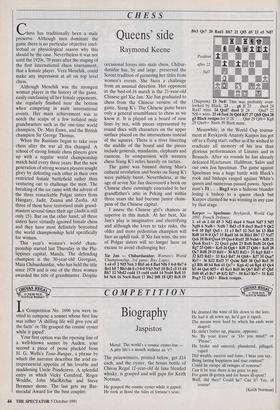CHESS
Queens' side
Raymond Keene
Chess has traditionally been a male preserve. Although men dominate the game there is no particular objective intel- lectual or physiological reason why this should be the case. Nevertheless it was not until the 1920s, 70 years after the staging of the first international chess tournament, that a female player, Vera Menchik, could make any impression at all on top level chess.
Although Menchik was the strongest woman player in the history of the game, easily outclassing all her female opponents, she regularly finished near the bottom when competing in male international events. Her main achievement was to notch the scalps of a few isolated male grandmasters such as the one-time world champion, Dr. Max Euwe, and the British champion Sir George Thomas.
When the Russians began to take over chess after the war all this changed. A school of strong female chess players grew up with a regular world championship match held every three years. But the new generation of strong women players sought glory by defeating each other in their own restricted female battlefield rather than venturing out to challenge the men. The breaking of the ice came with the advent of the three remarkable Polgar sisters from Hungary, Judit, Zsuzsa and Zsofia. All three of them have terrorised male grand- masters several times their age (Judit is still only 15). But on the other hand, all three sisters have virtually ignored female chess and they have most definitely boycotted the world championship held specifically for women.
This year's women's world cham- pionship started last Thursday in the Phi- lippines capital, Manila. The defending champion is the 30-year-old Georgian, Maia Chiburdanidze, who has held the title since 1978 and is one of the three women awarded the title of grandmaster. Despite occasional forays into male chess, Chibur- danidze has, by and large, preserved the Soviet tradition of garnering her titles from women's events. She faces a challenge from an unusual direction. Her opponent in the best-of-16 match is the 21-year-old Chinese girl Xie Jun. Xie Jun graduated to chess from the Chinese version of the game, Siang K'i. The Chinese game bears only a general resemblance to chess as we know it. It is played on a board of nine lines by ten, with pieces represented by round discs with characters on the upper surface placed on the intersections instead of the squares. There is a river bisecting the middle of the board and the pieces include generals, mandarins, elephants and cannons. In comparision with western chess Siang K'i relies heavily on tactics.
The game was banned during Mao's cultural revolution and books on Siang K'i were publicly burnt. Nevertheless, at the age of seven Xie Jun discovered a book on Chinese chess cunningly concealed ln her grandfather's attic in Peking and within three years she had become junior cham- pion of the Chinese capital.
I assess the Chinese girl's chances as superior in this match. At her best, Xie Jun's play is imaginative and electrifying and although she loves to take risks, the older and more pedestrian champion will face an uphill task. If Xie Jun wins, the trio of Polgar sisters will no longer have an excuse to avoid challenging her.
Xie Jun — Chiburdanidze: Women's World Championship, 3rd game; Ruy Lopez.
1 e4 e5 2 Nf3 Nc6 3 Bb5 a6 4 Ba4 Nf6 5 0-0 Be7 6 Re! 135 7 Bb3 db S c3 0-09 h3 Na5 10 Bc2 c5 11 d4 Bb7 12 Nbd2 cxd4 13 cxd4 exd4 14 Nxd4 Re8 15 b4 Nc6 16 Nxc6 Bxcb 17 Bb2 Bf8 18 Qf3 Rc8 19 Bb3 Qe7 20 Radl Bb7 21 Qf5 d5 22 e5 Nd7
Position after 22 . . . Nd7 (Diagram) 23 Ne4! This was probably over- looked by Black. 23. . . g6 If 23 . . . dxe4 24 Rxd7 wins. 24 Qxd7 dxe4 If 24. . . Qxd7 25 Nf6+ wins. 25 e6 fxe6 26 Qd4 Kf7 27 Qh8 Qh4 28 g3 Black resigns for if 28 . . . Qh6 29 Qf6+ Kg8 29 Qxe6+ Rxe6 30 Bxe6 mate.
Meanwhile, in the World Cup tourna- ment at Reykjavik Anatoly Karpov has got off to a flying start, rather as if he wished to eradicate all memory of his less than glorious performances at Linares and in Brussels. After six rounds he has already defeated Hjartarson. Halifman, Salov and our own Jon Speelman. The game against Speelman was a huge battle with Black's rook and bishops ranged against White's queen and numerous passed pawns. Speel- man's 51 . . . Bxg3 was a hideous blunder losing a bishop to a queen check but Karpov claimed he was winning in any case by that stage.
Karpov — Speelman: Reykjavik, World Cup 1991; French Defence.
1. e4 e6 2 d4 d5 3 Nd2 dxe4 4 Nxe4 Nd7 5 Nf3 Ngf6 6 Nxf6+ Nxf6 7 Bd3 c5 8 (1=5 Bxc5 9 Qe2 0-0 10 Bg5 Qa5+ 11 c3 Be7 12 Ne5 h6 13 Bh4 Rd8 14 0-0 Qc7 15 Radl bb 16 Rfel Bb7 17 Nxf7 Qc6 18 Be4 Qxe4 19 Qxe4 Rxdl 20 Nxh6+ 1(18 21 Qxe6 Rxel+ 22 Qxel gxh6 23 Bxf6 13):16 24 Qe6 Bg7 25 Qd6+ Ke8 26 Qg6+ Kf8 27 Qd6+ Ke8 28 Qc7 Rd8 29 f3 Rdl+ 301(12 Rd2+ 31 Kgl Rdl + 321(12 Rd2+ 33 Ke3 Rd7 34 Qb8+ KU 35 Qxa7 Re7+ 36 Kf2 Bxf3 37 Qxb6 Bd5 38 Qa5 Re5 39 g3 Bf6 40 h4 Be6 41 Qc7+ Kg6 42 a4 Bg4 43 Qc4 h5 44 Qa6 Rf5+ 45 Kel Rd5 46 Qb7 Rd7 47 Qb5 Bd8 48 a5 Bc7 49 Kf2 R17+ 50 Ke3 Re7+ 51 Kd2 Bxg3 52 Qd3+ Black resigns.


















































 Previous page
Previous page